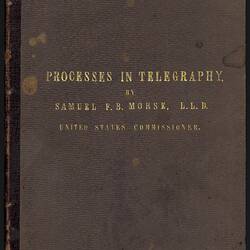The book is entitled Paris Universal Exposition, 1867 Reports of the United States Commissioners Examination of the Telegraphic Apparatus and the Processes in Telegraphy.
Background
In the United States, Samuel F. B. Morse developed what became the most widely used form of electric telegraph. He sent the first public message using his system in 1847. Samuel Walker McGowan, who introduced the Morse electric telegraph to Victoria and Australia in 1854, was a friend and former pupil of Morse. At the Paris Universal Exposition of 1867, the exhibits included a range of telegraphic equipment. Samuel Morse was a United States Commissioner to the Exposition and he prepared a report on the telegraphic equipment on display. His report also includes a history of the development of the telegraph, a survey of current technology, and information on the extent of telegraphic services throughout the world.
How Museum Victoria got the book
In searching for remnants of the 'telegraphic' dinner service owned by Samuel Walker McGowan, Museum Victoria made contact with Ms Patricia Rowland, a descendant of McGowan currently living in Queensland. Ms Rowland located a dinner service plate and arranged for it to be donated by her mother to Museum Victoria. When the plate arrived at the Museum it was accompanied by a copy of Morse's report on the 1867 Paris Exposition. The book was inscribed in Morse's hand writing, and carried Samuel McGowan's signature.
Description of the book
The book is 23.5 cm high, 15 cm wide and about 1.5 cm thick, and has 166 pages. It is hard-backed, and bound in cloth. The title is blocked in gold on the front cover. There is considerable foxing of the endpapers, and also some insect damage.
The book was published by the Government Printing Office in Washington in 1869. The title page carries the underlined handwritten inscription 'With the author's compliments', presumably in Morse's handwriting. The inside front cover is signed in the top left hand corner with the signature 'S. W. McGowan'.
The book has six chapters and six appendices.
The chapters cover Telegraphs; Semaphores; Codes; Batteries, Conductors and Insulators; Automatic Recording, Transmitting and Controlling; and Information Concerning Telegraphs in Various Countries.
The Appendices provide statistics on the distribution of telegraph systems in the world, a discussion of whether England or the United States invented the telegraph, a description of some semaphore telegraphs, a catalogue of works on telegraphy, and a catalogue of exhibits. In the chapter on Information Concerning Telegraphs in Various Countries, Samuel McGowan has supplied information on telegraph systems operating in Victoria and other Australian states, and in New Zealand, as of November 1868. The information provided by McGowan included details of the number of Morse systems in use, comments on the systems he had found most suitable for Australian conditions, and a comment that the English single and double needle systems had been used in South Australia for a limited time but had been replaced by Morse instruments.
More Information
-
Keywords
-
Authors
-
Article types

